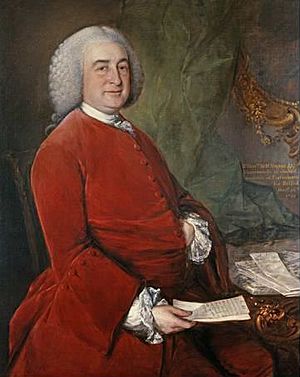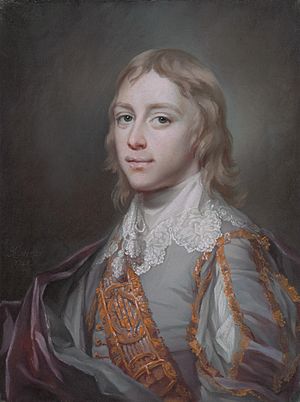Robert Nugent, 1st Earl Nugent facts for kids
Quick facts for kids
The Earl Nugent
|
|
|---|---|

Portrait by Thomas Gainsborough
|
|
| First Lord of Trade | |
| In office 19 January 1767 – 20 January 1768 |
|
| Monarch | George III |
| Prime Minister | The Earl of Chatham |
| Preceded by | The Earl of Hillsborough |
| Succeeded by | The Earl of Hillsborough |
Robert Craggs-Nugent (1709 – 13 October 1788) was an important Irish politician and a poet. He held many significant roles in the British government during the 1700s. He was known for his political skills and for writing poetry.
Contents
Early Life and Family Background
Robert Nugent was born in 1709 in Carlanstown, County Westmeath, Ireland. His father was Michael Nugent. His mother was Mary Barnewall. Her father was the 9th Baron Trimlestown. Robert took over the family property in Carlanstown in 1739.
Robert Nugent's Political Career
Robert Craggs-Nugent had a long and successful career in politics. He was a member of the British Parliament for many years. His journey in politics began because of his first wife's property.
Representing St Mawes and Bristol
Nugent's first wife owned land in St Mawes, Cornwall. This land included the right to vote for a Member of Parliament. Because of this, Nugent became the representative for St Mawes from 1741 to 1754. After that, he represented the city of Bristol until 1774. He then returned to represent St Mawes again. By 1782, he had served in Parliament longer than anyone else. This made him the "Father of the House."
Working for the Prince of Wales
In 1747, Robert Nugent started working for Frederick, the Prince of Wales. He became the Prince's Comptroller of the Household. This was an important job in the royal household. Nugent lent the Prince large amounts of money. These loans were never paid back. Later in his life, Nugent received many important jobs and noble titles. Many people believe this was because the Prince's son, King George III, wanted to repay Nugent.
Key Government Roles
Robert Craggs-Nugent held several high-ranking positions in the government. From 1754 to 1759, he was a Lord of the Treasury. This role involved managing government money. In 1759, he became a Privy Counsellor. This meant he was a trusted advisor to the King.
He served as Vice-Treasurer of Ireland from 1759 to 1765. He then became the First Lord of Trade from 1766 to 1768. This role involved overseeing trade policies. He was again Vice-Treasurer of Ireland from 1768 to 1782. In 1768, he also joined the Irish Privy Council.
Becoming a Peer
Nugent's strong support for the government was very helpful. Because of his service, he was given several noble titles. In 1767, he became Baron Nugent and Viscount Clare. In 1776, he was made Earl Nugent. All these titles were Irish peerages.
Robert Nugent's Poetry
Besides his political work, Lord Nugent also wrote poetry. Some of his poems are still saved today. They can be found in a collection called Dodsley's Collections, which was published in 1748.
Family Life
Lord Nugent was married three times during his life.
First Marriage
His first marriage was on 14 July 1730, to Emilia Plunkett. She was the daughter of the 4th Earl of Fingall. Sadly, Emilia passed away in 1731 during childbirth. They had one son named Edmund. Edmund later became a Lieutenant-Colonel. He passed away in 1771. Edmund had two sons who were born outside of marriage. These sons later became famous. One was Sir George Nugent, 1st Baronet, who became a Field Marshal. The other was Sir Charles Edmund Nugent, who became an Admiral of the Fleet.
Second Marriage
Nugent married his second wife, Anna Knight, on 23 March 1736. Anna was the widow of John Knight. She was also the sister of James Craggs, a Secretary of State. Anna had been widowed twice before marrying Robert. When they married, Robert adopted the surname Craggs-Nugent. Anna passed away in 1756.
Third Marriage
His third marriage was on 2 January 1757, to Elizabeth Drax. Elizabeth was the widow of the 4th Earl of Berkeley. She brought a large fortune to the marriage. Robert and Elizabeth had two daughters together. Elizabeth passed away in 1792.
The title of Earl Nugent later passed down through his son-in-law, George Nugent-Temple-Grenville, 1st Marquess of Buckingham. It then went to the future dukes of Buckingham and Chandos.


